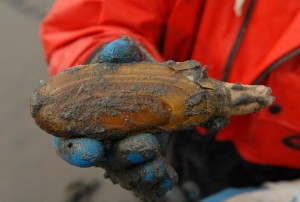
A new study says the levels of toxins responsible for Paralytic Shellfish Poisoning taken from samples around Haines this summer are all well above the Food and Drug Administration’s limit.
Senior scientist Bruce Wright with the Aleutian Pribilof Islands Association says the PSP situation has been dire in Alaska for years, but new findings suggest it’s getting worse.
Wright says in a recent study that the levels of the toxin that causes PSP are higher and more prevalent than ever before.
According to the study, samples were collected in May and June of this year in Chilkoot Inlet, Taiyasanka Harbor and Viking Cove. All species tested in 2015 exceeded the FDA limit of 80 micrograms, per 100 grams. Dungeness crab from Tiayasanka Harbor tested the highest for PSP at 810 µg/100g, according to the study.
“Some of the animals concentrate the toxins, and one pathway is through bivalves: clams, mussels, scallops, oysters,” Wright says.
But crabs are a little different. The toxins, which originates in algae, concentrate in the guts or viscera, not the meat. Shellfish affected by the poison don’t look, smell or taste any different than healthy ones. But once ingested, it can be deadly. Symptoms include tingling in the lips, mouth and extremities and can progress to dizziness and shortness of breath. According to the state, death can occur in as little as two hours in severe cases. Cooking or freezing shellfish does not get rid of PSP.
Wright also says anything that eat bivalves or crab affected by PSP can get sick or die. There have been reported cases of PSP in humans in Alaska, with several deaths attributed to the poisoning.
“Sea otters, people, bears, wolves, whatever goes out and digs clams or eats mussels off the rocks, they’re at risk of getting PSP and dying.”
Wright says that annual summer PSP spikes can happen in bays and coves where the organism that causes PSP flourishes, but the randomness of these PSP events can be perplexing and future PSP levels are difficult to predict. Sampling began in the Haines area in 2010 after a PSP scare.
He suggests more monitoring of algae blooms that harbor PSP would be a good start for protecting the public. But people who harvest bivalves to eat fresh, do so at their own risk.
“Just one of those little two-and-a-half in mussels from Viking Cove last year, could kill the whole boatload of people, 10 people – one mussel,” says Wright.
As for Dungeness crab and shrimp that Wright tested, high levels of PSP were found in the guts, which people mostly don’t eat, he says. If the crab or shrimp are cleaned before consumption, the meat is safe to eat. On the commercial end, live crab is not tested for PSP in Alaska before it is sold. Wright says if it was tested, the live crab fishery in northern Southeast Alaska would cease to exist.
“They should be tested,” Wright says. “These hotspots should be tested, or they should have non-live crab fishery. That’s what the regulations should require.”
Longtime Haines crabber Terry Pardee disagrees.
“I feed my family Dungeness crab, I eat them… it’s just nonsense,” he says.
Pardee says some of his customers cook the crab whole and eat everything, including the guts.
“And as far as I know everyone is still alive.”
To be clear, Pardee isn’t denying that PSP exists, he says. And while he says he aware of high levels of PSP in bivalves …
“There’s been no evidence whatsoever linking anybody that afflicted by, or died of, PSP from eating Dungeness crab.”
Pardee says after a fisherman passed away in 2010 from what was originally thought to be PSP, his business suffered. According to news reports at the time, the State Medical Examiner determined the cause of death to be heart disease, though the Alaska Department of Health and Social Services maintained the culprit was PSP. A spokesperson from the Medical Examiner’s office said the death records are private and released only to family.
Partee says his catches are safe.
“Nor am I going to feed anybody a product that’s dangerous,” he says.
George Scanlan is the shellfish permit coordinator for DEC Food Safety and Sanitation. He says the DEC does test live Dungeness crab, but only the processed ones that have been eviscerated. Scanlan says when it comes to live commercial crab, it’s a case of consumer beware because the department doesn’t have regulatory oversight.
“Our guidance basically to folks is that if they are to consume Dungeness crabs that are not tested, we strongly recommend that they clean out the butter,” Scanlan says.
Louisa Castrodale is an epidemiologist with the state health department. She says that samples that have tested high don’t automatically equate to human illness.
“I think that’s one of the trickiest things about PSP is that we’re all looking for some great predictors of when you might expect more illness and it’s more complex than that,” she says.
She says reports of illness from apparent cases of PSP happen all year and there have been some this summer.
“We do tend to get more in the summer when there’s more people out and there’s a big minus tide and things are going on with the algae we’ll hear about it more. It’s a difficult situation because the absence of case reports doesn’t necessarily mean absence of risk.”
Many factors contribute to whether the toxin rears up or not. And so knowing when and where the shellfish will have toxins, if at all, is impossible to predict.
But Wright maintains that there is no stopping PSP. Monitoring is one answer to curbing the number of people who get sick, as well as taking stock of when and how bivalves are harvested.




